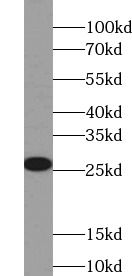Products
GSTA2 antibody
Category:
Research Area:
| Synonyms: | Glutathione S transferase A2 antibody, GST class alpha member 2 antibody, GST gamma antibody, GST HA subunit 2 antibody, GST2 antibody, GSTA2 antibody, GSTA2 2 antibody, GTA2 antibody, GTH2 antibody | ||
| Catalogue No.: | FNab03687 | Reactivity: | Human, Mouse, Rat |
| Host: | Rabbit | Tested Application: | ELISA, WB, IHC |
| Clonality: | polyclonal | Isotype: | IgG |
- SPECIFICATIONS
- Product Name
- GSTA2 antibody
- Catalogue No.
- FNab03687
- Size
- 100μg
- Form
- liquid
- Purification
- Immunogen affinity purified
- Purity
- ≥95% as determined by SDS-PAGE
- Clonality
- polyclonal
- Isotype
- IgG
- Storage
- PBS with 0.02% sodium azide and 50% glycerol pH 7.3, -20℃ for 12 months (Avoid repeated freeze / thaw cycles.)
Immunogen
- Immunogen
- glutathione S-transferase alpha 2
- Alternative Names
- Glutathione S transferase A2 antibody, GST class alpha member 2 antibody, GST gamma antibody, GST HA subunit 2 antibody, GST2 antibody, GSTA2 antibody, GSTA2 2 antibody, GTA2 antibody, GTH2 antibody
- UniProt ID
- P09210
- Observed MW
- 25 kDa
Application
- Tested Applications
- ELISA, WB, IHC
- Recommended dilution
- WB: 1:500 - 1:2000; IHC: 1:50 - 1:200
Validated Images
 HEK-293 cells were subjected to SDS PAGE followed by western blot with FNab03687(GSTA2 antibody) at dilution of 1:1000
HEK-293 cells were subjected to SDS PAGE followed by western blot with FNab03687(GSTA2 antibody) at dilution of 1:1000
 Immunohistochemistry of paraffin-embedded human prostate cancer using FNab03687(GSTA2 antibody) at dilution of 1:100
Immunohistochemistry of paraffin-embedded human prostate cancer using FNab03687(GSTA2 antibody) at dilution of 1:100
- Background
- Cytosolic and membrane-bound forms of glutathione S-transferase are encoded by two distinct supergene families. These enzymes function in the detoxification of electrophilic compounds, including carcinogens, therapeutic drugs, environmental toxins and products of oxidative stress, by conjugation with glutathione. The genes encoding these enzymes are known to be highly polymorphic. These genetic variations can change an individual's susceptibility to carcinogens and toxins as well as affect the toxicity and efficacy of some drugs. At present, eight distinct classes of the soluble cytoplasmic mammalian glutathione S-transferases have been identified: alpha, kappa, mu, omega, pi, sigma, theta and zeta. This gene encodes a glutathione S-tranferase belonging to the alpha class. The alpha class genes, located in a cluster mapped to chromosome 6, are the most abundantly expressed glutathione S-transferases in liver. In addition to metabolizing bilirubin and certain anti- cancer drugs in the liver, the alpha class of these enzymes exhibit glutathione peroxidase activity thereby protecting the cells from reactive oxygen species and the products of peroxidation.



